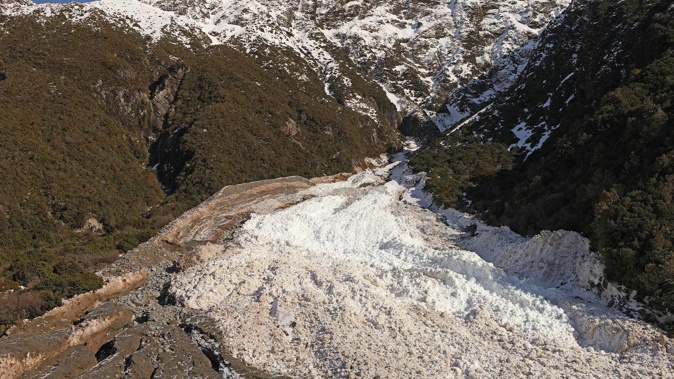
An extreme winter rainstorm that triggered one of the largest avalanche cycles observed in decades has raised fresh questions about the risk of more of these hazardous events under climate change.
Amid what was the country’s warmest and wettest winter to date, the storm that drenched the Southern Alps over July 18-19 last year was a stand-out.
The 547mm of rain that dropped on the alps - over just a 72-hour period - was unprecedented in records stretching back to the 1920s.
The deluge also happened to come at a time of year - and at elevations - where the mountains would’ve normally been receiving snow rather than torrential rain.
The dramatic result of hundreds of millimetres of rainfall on an above-average snowpack was the biggest avalanche observed in Aoraki Mount Cook National Park’s Kitchener Path in nearly 40 years.
It surged down the mountain toward Aoraki/Mt Cook village, running along a diversion berm that’d been designed to protect the settlement against one-in-100-year avalanches, before wiping out nearly 9000sq m of vegetation.
When the weather cleared, residents could clearly see their village surrounded by massive avalanches that would have swept away anyone in their path – but the berm appeared to have stopped them causing more damage to the landscape.
For Otago University researcher Aubrey Miller and his colleagues, the freak storm and avalanche left much to understand.
“The reason we wanted to study this event in detail is because it was an opportunity to look closely at an extreme event that many are worried may become more frequent or more likely in the future,” said Miller, a member of Otago’s Mountain Research Centre.
“Significant rain typically is a concern for flooding - but the other hazards are important to understand as well, as this event showed.”
Miller pointed out that avalanches themselves weren’t uncommon in New Zealand – hundreds were reported between 1999 and 2018 alone – nor were those triggered by “rain-on-snow” events.
“But the timing of this July 2022 storm was unusual,” he said.
Study co-author Todd Redpath, also of Otago University, said there’d been 16 instances of 24-hour rainfall exceeding 300mm at Mt Cook Village, but before this storm, all had been in the spring, summer or autumn months.
Overseas, Miller said there was interest among scientists in the mechanics of heavy rain falling on snow – especially in areas, such as the European alps, where that was a rare but increasing occurrence under climate change.
“If we can better understand the dynamics of the avalanches induced by extreme rain, then we can better anticipate future risks posed to people and infrastructure from extreme rain events falling on snow.”
In their study, carried out in collaboration with the Department of Conservation, the research team used data from drone-mounted equipment to map the avalanche path at fine-scale resolution.
They also used specially-developed modelling software to simulate and analyse the avalanche dynamics.
Their findings, published in the journal Geophysical Research Letters, confirmed the largest avalanche cycle was the largest seen since at least 1986 – and that the Kitchener path and berm had performed as designed.
They also found how a domino-like series of drivers had set up the historic surges.
“The timing of the rain after a snowy start to the winter season, coupled with the intensity of the rain, saturated the snowpack to the point that a widespread mass-movement cycle developed,” Miller said.
“While more than 370mm of rain fell in 24 hours, it took only around 100mm before the snow avalanche released.”
A view of Mt Cook village from the Red Tarns track. Photo / Paul Rush
Importantly, that suggested we may see other large avalanche cycles in future - even with slightly more modest storms, if the other driving factors line up.
“In other words, the snowpack couldn’t contain more than 100mm of rain before releasing the large avalanches, in this case,” Miller said.
“More research is needed on the exact timing and triggers for these rain-on-snow avalanches.
“The fact the rain fell in mid-winter when the snowpack was less consolidated means it probably couldn’t withstand as much of the rain before releasing.”
Another big take-away from the study was the need for future-proofed avalanche defences.
Miller said that, although it wasn’t likely the avalanche would’ve reached the village without the berm, it stopped much more forest from being destroyed.
“But when it comes to designing mitigation for communities, it may be that the existing one-in-100 year standards, based on runout distance of observed avalanches, might not adequately account for the impacts of climate change on the frequency of extreme rain.”
Compared with other countries, New Zealand had less exposed infrastructure like houses, roads and railroads in its mountainous areas – yet there was still a present risk to structures like back-country huts and the recreationists who used them.
“How the hazard will evolve in the future is still a difficult question,” Miller said.
“It’s likely climate change will impact the timing and intensity of winter storms, and we can expect more extreme rain events.”
“But,” Redpath added, “given the existing baseline variability in storm intensity and frequency in New Zealand – which has a very maritime climate – it’s hard to quantify, and is an area of ongoing research.”
Take your Radio, Podcasts and Music with you









